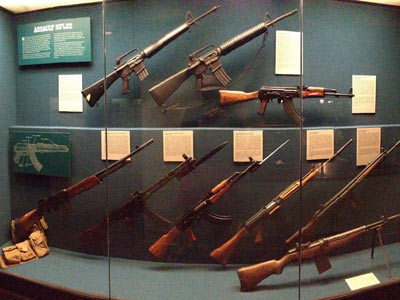The oldest American firearm museums are associated with the military, where firearms could be studied by designers and soldiers alike. The West Point Museum is within the U.S. Army’s Enterprise system of one hundred and five museums. Because West Point is the country’s premier military academy, it is curated by museum professionals who have made smart and economical choices of the guns shown, and the wall texts are finely written. Firearms are displayed in two ways: in the context of military artifacts in the main galleries and in the Small Arms Gallery that focuses solely on weaponry. Guns with strategic or personal histories are displayed throughout the museum’s excellent exhibits of military history and its personalities. The themed ‘Surrender’ case has Herman Goering’s .38 Smith & Wesson and Hitler’s Lilliput. The Small Arms Gallery gives a near perfect tour through the history of small arms, including everything from Neolithic stone clubs to the U.S. Army’s current side arm, the M9 (Beretta 92 SB-F). Fourteen cases of firearm actions include: Hand Cannon, Matchlock, Wheel Lock, Snaphaunce, Miquelet & Flintlock, Percussion, Breech Loaders, Early Repeaters, Bolt Action, Self-Loading Rifles, Assault Rifles, Submachine Guns, Light Machine Guns, Pistols, and Cartridges and present clear drawings of how each type works. Highlights include the 1776 Ferguson Breechloading Rifle and a Springfield 1903 rifle fitted with a Pedersen device. The museum is home to the John T. Pitman Collection of ammunition, including some of his notes. On display is a small but excellent exhibit of the history of cartridge design and a close-up display of the Winchester ‘W’ cartridge board. With 1/6th of the collection on display, the museum has a substantial number of historic firearms and ammunition in storage. The curatorial stance of the Small Arms Gallery is periodically updated, but generally weapons from the most recent conflicts are absent. United States Military Academy
http://www.westpoint.army.mil/museum_SmallWeapons.html
http://www.williammaloney.com/Aviation/WestPointMilitaryMuseum/index.htm


 1. West Point Museum
1. West Point Museum 2. Springfield Armory
2. Springfield Armory 3. Smithsonian Museum
3. Smithsonian Museum 4. Nunnemacher Milwaukee
4. Nunnemacher Milwaukee 5. Wadsworth Atheneum
5. Wadsworth Atheneum 6. Rock Island Arsenal
6. Rock Island Arsenal 7. Metropolitan Museum NY
7. Metropolitan Museum NY 8. National World War I
8. National World War I 9. FBI Reference Collection
9. FBI Reference Collection 10. NRA National Firearms
10. NRA National Firearms 11. Connecticut History
11. Connecticut History 12. Remington Firearms
12. Remington Firearms 13. Davis Arms Museum
13. Davis Arms Museum 14. National Cowboy Mus.
14. National Cowboy Mus. 15. American Precision
15. American Precision 16. Collectors Firearms
16. Collectors Firearms 17. KY Military History
17. KY Military History 18. Cody Firearms Museum
18. Cody Firearms Museum 19. Woolaroc Museum
19. Woolaroc Museum 20. Kienbusch Philadelphia
20. Kienbusch Philadelphia 21. John Browning Museum
21. John Browning Museum 22. Art Institute Chicago
22. Art Institute Chicago 23. Henry Stewart VMI
23. Henry Stewart VMI 24. Autry Museum
24. Autry Museum 25. Wood Museum S&W
25. Wood Museum S&W 26. National WWII Museum
26. National WWII Museum 27. Frazier History Museum
27. Frazier History Museum 28. Pennsylvania Longrifle
28. Pennsylvania Longrifle 29. Frank Brownell Museum
29. Frank Brownell Museum 30. Inst. Mil. Technology
30. Inst. Mil. Technology 31. NRA Bass Pro Sporting
31. NRA Bass Pro Sporting 32. U S Army Museum
32. U S Army Museum